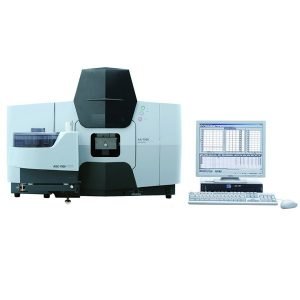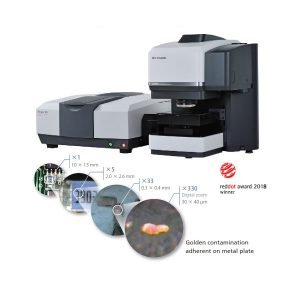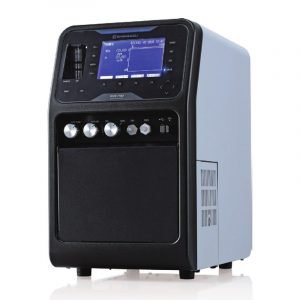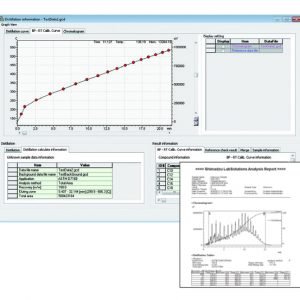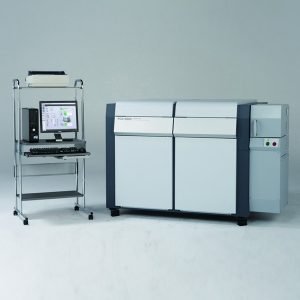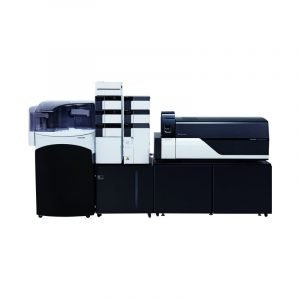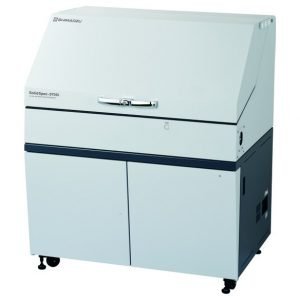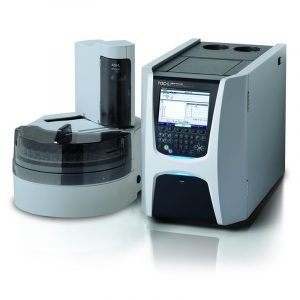Gas Chromatograph-Mass Spectrometers
The GCMS-TQ8050 NX features a new highly efficient detector and three noise reduction technologies that enable previously unachievable femtogram-level quantitative analysis of ultra trace quantities.
- Description
Description
Description
Triple Quadrupole Gas Chromatograph Mass Spectrometer
GCMS-TQ™ 8050 NX
Ultra High-Sensitivity Triple Quadrupole GC-MS System for Pioneering New Fields
 The system also enables quantitative analysis for a variety of new applications, such as utilizing the dramatically high sensitivity for reducing the maintenance frequency and cost of long-term use, for example, or the high mass resolution to achieve even higher separation from contaminants.
The system also enables quantitative analysis for a variety of new applications, such as utilizing the dramatically high sensitivity for reducing the maintenance frequency and cost of long-term use, for example, or the high mass resolution to achieve even higher separation from contaminants.
High-Sensitivity Detection of Ultra Trace Ion Quantities
The ability to detect ultra trace quantities of ions means high quantitative accuracy can be achieved even from trace sample quantities. Therefore, injection volumes can be reduced during analysis to reduce the analytical loads on the insert, column, ion source, and other parts, and also further reduce maintenance frequency.

Even Supports Analyzing Environmental Pollutants that Require Trace Analysis

Triple Quadrupole Gas Chromatograph Mass Spectrometer
GCMS-TQ8040 NX
Smart Performance that Boosts Routine Analytical Work
 Smart performance offers simultaneous high-sensitivity analysis of multiple components, smart productivity achieves outstanding productivity with thorough efficiency improvements, and smart operation provides support for easy method creation and data analysis. In combination, these three types of “smart” features provide a universal triple quadrupole GC-MS system that offers high performance for a wide variety of applications.
Smart performance offers simultaneous high-sensitivity analysis of multiple components, smart productivity achieves outstanding productivity with thorough efficiency improvements, and smart operation provides support for easy method creation and data analysis. In combination, these three types of “smart” features provide a universal triple quadrupole GC-MS system that offers high performance for a wide variety of applications.
Qualitative Analytical Using GC-MS/MS
GC-MS/MS allows users to freely select ions cleaved by electron ionization (EI), and then cleave precursor ions via collision induced dissociation (CID), which enables a detailed analysis of partial structures. A product ion scan can be used to easily discriminate between structural isomers and positional isomers, which are hard to identify from EI mass spectra obtained with a single GC-MS system. That makes product ion scans ideal for predicting partial structures.

Simultaneous Analysis of 439 Pesticide Components by Smart MRM Scan

Gas Chromatograph Mass Spectrometer
GCMS-QP2020 NX
Smart Solutions for Maximizing the Potential of Laboratories
 GC-MS systems, which are used in all sorts of fields, have now become a general purpose tool for analysis. Consequently, customers are increasingly demanding GC-MS systems that offer higher performance for the cost and enable a better work-life balance for operators. The GCMS-QP2020 NX maximizes the potential of laboratories by offering efficiency improvements for various aspects of analytical work.
GC-MS systems, which are used in all sorts of fields, have now become a general purpose tool for analysis. Consequently, customers are increasingly demanding GC-MS systems that offer higher performance for the cost and enable a better work-life balance for operators. The GCMS-QP2020 NX maximizes the potential of laboratories by offering efficiency improvements for various aspects of analytical work.
Active Time Management ™
Active time management helps visualize how much time was spent on maintenance, switching between systems, or performing analyses, for example, to help manage the instrument downtime more appropriately. By automating tasks previously performed by users, it enables more efficient system operation.

Smart EI/CI Ion Source
The newly developed Smart EI/CI ion source can be used to acquire CI data without exchanging ion sources or losing the general applicability of EI sensitivity. With the EI mode, even if identification is difficult using a mass spectral library, molecular weight information can be collected from the CI mode data, which is especially useful for predicting unknown compounds.

| Gas Chromatograph Mass Spectrometer |
| GCMS-QP2010 SE |
 The GCMS-QP2010 SE is a high costperformance model featuring both a variety of functions and ease of operation. In addition to high level performance, the user friendly design ensures that anyone can quickly and easily acquire highly reliable data, with ease of operation and maintenance in every situation.
The GCMS-QP2010 SE is a high costperformance model featuring both a variety of functions and ease of operation. In addition to high level performance, the user friendly design ensures that anyone can quickly and easily acquire highly reliable data, with ease of operation and maintenance in every situation.

| Workstation for GC-MS |
| GCMS Insight Software Package |

GCMS Insight is workstation software for GC-MS and GC-MS/MS systems, combining GCMSsolution and LabSolutions Insight into a single package. This software dramatically improves the efficiency of the analysis process, thanks to a user interface that can be operated intuitively even by novices; automatic method creation and data analysis functions that make multi-analyte and multicomponent analysis easier; and reliable qualitative analysis functions using retention indices. In GC-MS analysis, a number of GC and MS parameters need to be optimized during data acquisition. The GCMSsolution automatic method creation function (Smart MRM/SIM), and automatic adjustment function for retention times (AART) make it possible to create optimal analytical methods automatically.
Furthermore, during data analysis, it is necessary to identify unknown components contained in samples, and to quantitatively determine over several hundreds of components quickly. LabSolutions Insight displays the chromatograms for each sample in sequence, making it easy to confirm peak detection results and whether criteria are exceeded. In addition, it displays quantitative results for each sample as a group. Thanks to the flagging function, peaks that deviate from the criteria are color-coded, making them instantly visually discernable. This dramatically reduces the number of peaks that need checking, so the process of quantitation can proceed efficiently.
| Workstation for GC-MS |
| GCMS Insight Software Package |

A great deal of effort is required to create MRM methods, including the optimization of transitions and collision energies, and the configuration of retention times using standard samples. With the Smart Database, compound information, transitions, and collision energies are preregistered. Methods configured with the optimal measurement times can be created automatically using the automatic adjustment of retention time (AART) and Smart MRM functions.

| Database for GC-MS and GC-MS/MS |
| Quick-DB™Series |

Quick-DB is a screening database that enables easy quantitation without using standard samples. The database contains not only optimized MRM transitions and other analytical conditions, but also data analysis conditions including retention indices and calibration curve information acquired using the internal standard method. Thanks to the automatic method creation function (Smart MRM/ SIM), it allows analytical methods to be created easily, and quantitative values to be calculated without using standard samples.

| Thermal Desorption System |
| TD-30 Series |

Thermal desorption systems heat samples in a sample tube and then concentrate the thermally desorbed gases before injection into a GC or GC-MS system. They are commonly used to measure volatile organic compounds (VOCs) in the atmosphere or measure trace components that are generated from plastic or other samples. It is now possible to target a wide variety of components, from low boiling point to high boiling point. The lineup includes the TD-30, which can hold a maximum of 60 samples, and the TD-30R, which can hold 120 samples and supports re-acquisition and the addition of internal standard substances.

| Screening System for Phthalate Esters |
| Py-Screener™ |

This system is designed for screening for phthalate esters in polymers. The use of phthalate esters is restricted in toys and food packaging and so on. They are expected to be regulated as restricted substances under the RoHS (II) Directive. The system supports a series of procedures from sample preparation to data acquisition, analysis, and maintenance. It consists of special software, special standard samples, and a sampling toolkit. It provides an environment in which even novices can operate it easily.

| GC-MS Application System |
| Off-Flavor Analyzer |
 This analysis system can reliably identify the substances responsible for off-flavor problems. To resolve off-flavor issues, the substances causing the odor must be identified. In order to accurately identify them however, expertise and experience are required to know what components are responsible for the off-flavor problems, to discriminate the quality of their odors and to use odor thresholds for those discriminations. The system provides a database of the major odor-causing substances, as well as sensory information (odor qualities and odor thresholds), for use in combination with GC-MS. It provides the total solution needed for offflavor analysis.
This analysis system can reliably identify the substances responsible for off-flavor problems. To resolve off-flavor issues, the substances causing the odor must be identified. In order to accurately identify them however, expertise and experience are required to know what components are responsible for the off-flavor problems, to discriminate the quality of their odors and to use odor thresholds for those discriminations. The system provides a database of the major odor-causing substances, as well as sensory information (odor qualities and odor thresholds), for use in combination with GC-MS. It provides the total solution needed for offflavor analysis.

| GC-MS Application System |
| AOC-6000 Plus Multifunctional Autosampler System |
 The AOC-6000 supports multiple sample injection methods including liquid sample injection, headspace (HS) injection and solid phase micro extraction (SPME). Consequently, it can be used for analyzing samples in wide range of formats. Furthermore, it can automatically switch between sample injection methods, so that a combination of different sample injection methods can be used within a single sequence of operations. New functions for managing syringe and fiber usage history support accurate analysis.
The AOC-6000 supports multiple sample injection methods including liquid sample injection, headspace (HS) injection and solid phase micro extraction (SPME). Consequently, it can be used for analyzing samples in wide range of formats. Furthermore, it can automatically switch between sample injection methods, so that a combination of different sample injection methods can be used within a single sequence of operations. New functions for managing syringe and fiber usage history support accurate analysis.

| GC-MS Application System |
| OPTIC-4 Multifunction Sample Injection System |
 The OPTIC-4 is a GC injection inlet that supports all GC-MS sample injection modes, including large-volume injection, injection port derivatization, thermal desorption, and difficult matrix introduction (DMI). It can be combined with the AOC-5000 Plus for automatic insert replacement to further enhance productivity for multi-sample analysis.
The OPTIC-4 is a GC injection inlet that supports all GC-MS sample injection modes, including large-volume injection, injection port derivatization, thermal desorption, and difficult matrix introduction (DMI). It can be combined with the AOC-5000 Plus for automatic insert replacement to further enhance productivity for multi-sample analysis.

| GC and GC-MS Application System |
| Headspace Analysis System |
 The headspace sampler holds samples at a fixed temperature, and introduces the volatile components that diffuse into the gaseous phase into GC or GC-MS. It is used for qualitative and quantitative analysis of odor components of foods, aroma components of chemicals, and toxic volatile components in environmental water.
The headspace sampler holds samples at a fixed temperature, and introduces the volatile components that diffuse into the gaseous phase into GC or GC-MS. It is used for qualitative and quantitative analysis of odor components of foods, aroma components of chemicals, and toxic volatile components in environmental water.

| GC and GC-MS Application System |
| Pyrolysis System |
 This system performs pyrolysis for polymer compounds at 500 °C or higher, and analyze the pyrolysates obtained via GC and GC-MS. Since these pyrolysates reflect the structure of the original polymer compounds, they can be used to identify the polymers, and for higher-order structural analysis. Search software using a pyrolysis library also assists in the identification process.
This system performs pyrolysis for polymer compounds at 500 °C or higher, and analyze the pyrolysates obtained via GC and GC-MS. Since these pyrolysates reflect the structure of the original polymer compounds, they can be used to identify the polymers, and for higher-order structural analysis. Search software using a pyrolysis library also assists in the identification process.

| Gas Chromatograph-Mass Spectrometer Differential split flow turbo molecular pump system |
| Comprehensive GC-MS (GC×GC-MS) System |
 The Comprehensive GC/MS (GC×GCMSq) technique employs a modulator to link two capillary columns of complementary orthogonal phases. The technique requires a GC-MS system capable of very fast data collection to fully capture the very narrow, fast eluting compounds. Sensitivity is also an important requirement for many Comprehensive GC×GC applications. The GCMS-TQ series, QP series were developed with this multi-dimensional technique in mind. Its best-in-class data collection speeds and superior sensitivity make it the top choice for Comprehensive Chromatography.
The Comprehensive GC/MS (GC×GCMSq) technique employs a modulator to link two capillary columns of complementary orthogonal phases. The technique requires a GC-MS system capable of very fast data collection to fully capture the very narrow, fast eluting compounds. Sensitivity is also an important requirement for many Comprehensive GC×GC applications. The GCMS-TQ series, QP series were developed with this multi-dimensional technique in mind. Its best-in-class data collection speeds and superior sensitivity make it the top choice for Comprehensive Chromatography.
| Multi-Dimensional GC/GC-MS System |
| MDGC/GCMS-2010 Series |
 This system performs separation using two columns that have different characteristics. It has a mechanism in which the components that are insufficiently separated in the first column they pass through are introduced (“heart-cut”) to a second, different column. This enables analysis with a level of separation that cannot be attained in conventional single-column analysis. This is effective for the analysis of samples containing a very large number of compounds, such as petroleum products and perfumes.
This system performs separation using two columns that have different characteristics. It has a mechanism in which the components that are insufficiently separated in the first column they pass through are introduced (“heart-cut”) to a second, different column. This enables analysis with a level of separation that cannot be attained in conventional single-column analysis. This is effective for the analysis of samples containing a very large number of compounds, such as petroleum products and perfumes.





